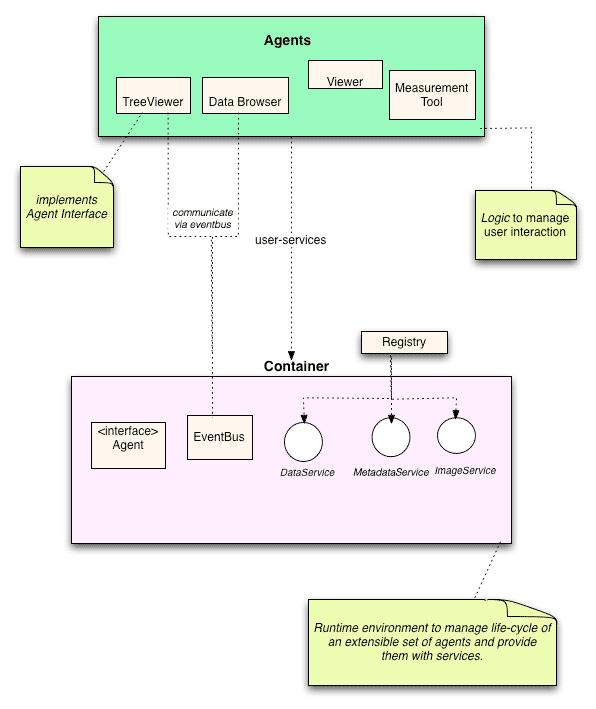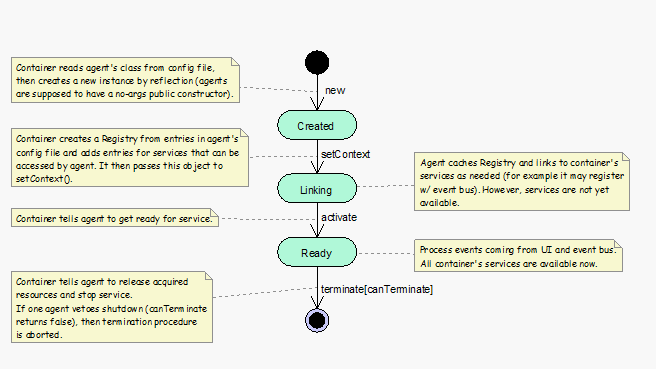Architecture¶
Note
With the release of OMERO 5.3.0, the OMERO.insight desktop client has entered maintenance mode, meaning it will only be updated if a major bug is discovered. Instead, the OME team will be focusing on developing the web clients. As a result, coding against this client is no longer recommended.
Logical view¶
OMERO.insight is logically organized in two layers

OMERO.insight agents and containers
The Agents layer contains the logic to manage user interaction. It contains coarse grained components which we call agents, that are each responsible for a specific aspect of the application’s functionality:
- The Data Manager provides the user with the GUI functionality to access their data, metadata and visualize large image sets.
- The Viewer is a tool to visualize and tune 5D images.
- The Measurement Tool is a tool to perform basic measurement.
Note
If you want to add a new agent, go to How to build an agent.
These agents are internally organized according to the MVC (` Model-View-Controller <https://en.wikipedia.org/wiki/Model-view-controller>`_) pattern, PAC (` Presentation-Abstraction-Control <https://en.wikipedia.org/wiki/Presentation-abstraction-control>`_) pattern, or a combination of the two. They rely on the services provided by the bottom layer, the Container, to accomplish their tasks.
The Container layer manages the agents life-cycle and provides them with services to:
- Communicate without having to know each other (Event bus).
- Access the OMERO Server (data management and image services).
- Transform entries in configuration files into objects and then access them (Configuration).
- Log messages (log service) and notify the user (user notification service) of runtime errors.
- Cache data (cache service).
- Provide a common top level window to plug their GUI’s (Taskbar).
Initialization of Agents¶
Agents let the container create them and then manage their life-cycle.
This is achieved through the use of a common interface, Agent, that
all agents have to implement and by requiring every agent to have a
public no-arguments constructor. The Agent interface plays the role of a
Separated Interface (Fow),
decoupling the container from knowledge of concrete agents. This way,
new agents can be plugged in.
At start-up the container finds out which are the agents’ implementation classes from its configuration file, instantiates every agent by reflection (using the no-arguments constructor) and then reads each agent’s configuration file (Fow). The configuration entries in this file are turned into objects and collected into a map-like object, which is then passed to the agent. This map object also contains pointers to the container’s services. We can think of this object as a Registry (Fow).
There is one Registry containing pointers to the container’s services for each agent, so configuration entries are private to each agent - container’s services are shared among all agents though. Agents access the Registry object through the Registry interface.
The life-cycle of an agent is as follow:

OMERO.insight agent lifecycle
Interaction among Agents¶
Interactions among agents are event-driven. Agents communicate by using a shared Event bus provided by the container. The event bus is an event propagation mechanism loosely based on the ` Publisher-Subscriber <https://en.wikipedia.org/wiki/Publish/subscribe>`_ pattern and can be regarded as a time-ordered event queue - if event A is posted on the bus before event B, then event A is also delivered before event B.
Process view¶
All agents run synchronously within the Swing dispatching thread. All container’s services are called within Swing event handlers and thus run within the Swing dispatching thread. To see how to retrieve data from an OMERO server, go to the Retrieve data from server page.
See also